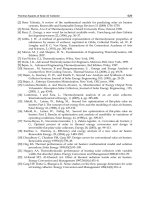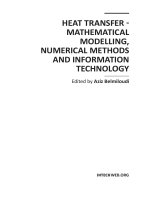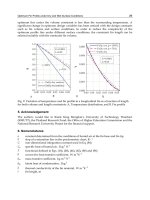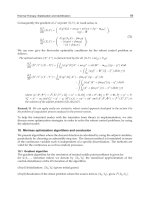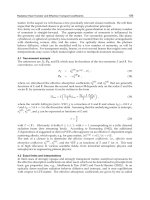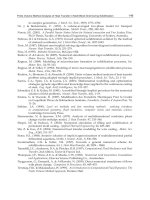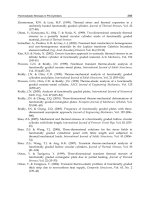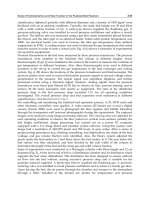Heat Transfer Theoretical Analysis Experimental Investigations and Industrial Systems part 10 potx
Bạn đang xem bản rút gọn của tài liệu. Xem và tải ngay bản đầy đủ của tài liệu tại đây (2.74 MB, 40 trang )
Heat Transfer - Theoretical Analysis, Experimental Investigations and Industrial Systems
350
Hijikata, K., Fukasaku, Y., Nakabeppu, O. (1996). Theoretical and Experimental Studies on
the Pseudo-Dropwise Condensation of a Binary Vapor Mixture, Journal of Heat
Transfer, Vol. 118, pp. 140-147.
Hovestreijdt, J. (1963). The Influence of the Surface Tension Difference on the Boiling of
Mixture, Chem. Eng. Sci., Vol. 18, pp. 631-639.
Mirkovich, V.V. and Missen, R.W. (1961). Non-Filmwise Condensation of Binary Vapor of
Miscible Liquids, Can. J. Chem. Eng., Vol. 39, pp. 86-87.
Morrison, J.N.A. and Deans, J. (1997). Augmentation of Steam Condensation Heat Transfer
by Addition of Ammonia, International Journal of Heat and Mass Transfer, Vol. 40,
pp. 765–772.
Murase, T., Wang, H.S., Rose, J.W. (2007). Marangoni condensation of steam-ethanol
mixtures on a horizontal tube, International Journal of Heat and Mass Transfer, Vol. 50,
pp. 3774-3779.
Tanasawa, I., Ochiai, J., Utaka, Y. and Enya, S. (1976). Experimental Study on Dropwise
Condensation Process (Effect of Departing Drop Size), Trans. JSME, Vol. 42, No.
361, pp. 2846-2853.
Utaka, Y. and Terachi, N. (1995a). Measurement of Condensation Characteristic Curves for
Binary Mixture of Steam and Ethanol Vapor, Heat Transfer-Japanese Research, Vol. 24,
pp. 57-67.
Utaka, Y. and Terachi, N. (1995b). Study on Condensation Heat Transfer for Steam-Ethanol
Vapor Mixture (Relation between Condensation Characteristic Curve and Modes of
Condensate), Transactions of Japan Society of Mechanical Engineers, Series B, Vol. 61,
No. 588, pp. 3059-3065.
Utaka, Y., Kenmotsu, T., Yokoyama, S. (1998). Study on Marangoni Condensation
(Measurement and Observation for Water and Ethanol Vapor Mixture), Proceedings
of 11th International Heat Transfer Conference, Vol. 6, pp. 397-402.
Utaka, Y. and Kobayashi, H. (2003). Effect of Vapor Velocity on Condensation Heat Transfer
for Water-Ethanol Binary Vapor Mixture, Proceedings of 6th ASME-JSME Thermal
Engineering Conference.
Utaka, Y. and Nishikawa, T. (2003a). An Investigation of Liquid Film Thickness during
solutal Marangoni Condensation Using a Laser Absorption Method (Absorption
Property and Examination of Measuring Method) , Heat Transfer – Asian Research,
Vol.32, No.8, pp.700-711.
Utaka, Y. and Nishikawa, T. (2003b). Measurement of Condensate Film Thickness for Solutal
Marangoni Condensation Applying Laser Extinction Method, Journal of Enhanced
Heat Transfer, Vol. 10, No. 1, pp. 119-129.
Utaka, Y. and Wang, S. (2004). Characteristic Curves and the Promotion Effect of Ethanol
Addition on Steam Condensation Heat Transfer, International Journal of Heat and
Mass Transfer, Vol. 47, pp. 4507-4516.
Wang, S. and Utaka, Y. (2005). An Experimental Study on the Effect of Non-condensable Gas
for Solutal Marangoni Condensation Heat Transfer, Experimental Heat Transfer, Vol.
18, No. 2, pp. 61-79.
Part 3
Heat Transfer Phenomena and Its Assessment
13
Quantitative Visualization of
Heat Transfer in
Oscillatory and Pulsatile Flows
Cila Herman
Department of Mechanical Engineering, The Johns Hopkins University
USA
1. Introduction
Oscillatory and pulsatile flows arise in a variety of engineering applications as well as in
nature. Typical examples include blood flow, breathing, flow in some pipe systems, acoustic
systems, etc. Typical engineering applications include enhancement of heat transfer and
species transport, chemical species separation, flow control, flow velocity measurement
equipment calibration and biomedical applications. Very often these flows are accompanied
by heat or mass transfer processes. During the past four decades numerous studies have
addressed issues specific for purely oscillatory and modulated or pulsatile flows
(oscillatory flow superimposed on a mean steady flow). Recent advances in the study of
oscillatory flows were reviewed by Cooper et al. (1993) and Herman (2000). A better
understanding of these flows and the accompanying heat transfer processes is essential for
the proper design of equipment for such processes and physical situations. Both the
experimental study and the computational modeling of oscillatory and pulsatile flows pose
specific challenges, which will be addressed in this chapter, with the emphasis on
quantitative experimental visualization using holographic interferometry.
Experimental visualization of oscillatory and pulsatile flows and heat transfer requires non-
invasive measurement techniques, to avoid affecting the investigated process. In this
chapter we discuss holographic interferometry (HI) as a powerful tool in the quantitative
visualization of oscillatory and pulsatile flows and heat transfer. Two situations will be
considered to demonstrate the applications of the method: (i) the study of self-sustained
oscillatory flows and the accompanying heat transfer in grooved and communicating
channels and the study of (ii) oscillatory flow and heat transfer in the stack region of
thermoacoustic refrigerators.
In this chapter we introduce holographic interferometry as an experimental technique that
simultaneously renders quantitative flow and heat transfer data. We demonstrate that for a
certain class of problems HI is superior to conventional flow visualization techniques, such
as tracer methods or dye injection, since it can provide not only qualitative but also
quantitative insight into certain types of unsteady flows and it does not require the seeding
of the flow. Several types of flows and heat transfer processes amenable for quantitative
evaluation will be analyzed in the paper. We begin the discussion by introducing the
experimental apparatus and technique, followed by the description of the investigated
Heat Transfer - Theoretical Analysis, Experimental Investigations and Industrial Systems
354
physical situation. Next, we present, based on three case studies, visualized temperature
fields along with numerous examples of how quantitative data can be extracted from
interferometric visualization images. Data reduction procedures, image processing tools,
experimental uncertainties as well as advantages and limitations of the method are
explained.
2. Real-time holographic interferometry for quantitative visualization of fluid
flow and heat transfer
Holographic Interferometry (HI) is a well-established measurement and visualization
technique widely used in engineering sciences (Vest, 1979; Hauf and Grigull, 1970). In
transparent fluids it visualizes refractive index fields, which are related to fluid properties,
such as temperature, pressure, species concentration, as well as density in compressible
flows. Optical measurement techniques have virtually no “inertia”, therefore they are ideal
tools for investigation of high-speed, unsteady processes. The combination of HI and high-
speed cinematography (that allows high spatial resolutions) is used in the present study to
visualize oscillatory or pulsatile flows.
Fig. 1. Optical arrangement for holographic interferometry
2.1 Optical arrangement for holographic interferometry
Holographic interferometry uses light as information carrier to provide both qualitative
(visual) insight and quantitative data on the investigated physical process. In convective
Quantitative Visualization of Heat Transfer in Oscillatory and Pulsatile Flows
355
heat transfer measurements the temperature fields in the thermal boundary layer above the
heated surface and in the transparent working fluid are of particular interest. For more
details about the technique, the reader is referred to the comprehensive literature on this
topic. General information can be found in the publications such as those of Vest (1979) and
Mayinger (1994). Specific information on the optical setup used in our studies can be found
in the descriptions by Amon et al. (1992).
A standard optical arrangement for HI is presented in Fig. 1. The light source is a laser. In
our research we used both a 25 mW Helium-Neon and a 1 W Argon-Ion laser. The laser
power required for analyzing a particular physical process depends on the speed of the
process, i.e. the highest frequency of oscillations in oscillatory and pulsatile flows, as well as
the sensitivity of the film or digital sensor used to record the high-speed image sequence, in
order to be able to resolve the smallest time scales of interest. The type and wavelength of
the laser determine the choice of holographic and film materials for highest sensitivity,
resolution and contrast, which is especially critical in high-speed applications.
For imaging by HI, the laser beam is divided into a reference beam, RB, and an object beam,
OB, by means of a, usually variable, semitransparent mirror (beam splitter), BS, as shown in
Fig. 1. Both beams are then expanded into parallel light bundles by a beam expander, BE,
which consists of a microscope objective, a spatial filter and a collimating lens. The object
beam passes through the test section, TS, with the phase object (representing the refractive
index field to be visualized and related to temperature, concentration or density in the
evaluation phase) and then falls on the holographic plate, H. The reference beam falls
directly onto the holographic plate. The photograph of the optical arrangement for
holographic interferometry in the Heat Transfer Lab of the Johns Hopkins University with
the thermoacoustic refrigerator model mounted on the optical table is displayed in Fig. 2.
Fig. 2. Photograph of the optical arrangement for holographic interferometry at the Heat
Transfer Lab of the Johns Hopkins University and the thermoacoustic refrigerator model
mounted on the optical table.
Heat Transfer - Theoretical Analysis, Experimental Investigations and Industrial Systems
356
2.2 Visualization of temperature fields: infinite and finite fringe field arrangements
HI allows the visualization and analysis of high-speed, transient phenomena by using the
real-time method, which is a single exposure technique. The visualization is carried out in
two steps. First, the reference state (usually with the fluid in the measurement volume at
ambient temperature) is recorded on the holographic plate. Next, the holographic plate is
developed, bleached, dried and exactly repositioned into a precision plate holder. In the
second step, the reference state of the object under investigation is reconstructed by
illuminating the holographic plate with the reference beam. At the same time, the
investigated physical process is initiated (in our experiment the blocks in the wind tunnel
are heated or the thermoacoustic refrigerator is activated). The heating causes the refractive
index of the fluid in the measurement volume to change, and, consequently, this causes the
object wave to experience a phase shift on its way through the test section. The difference
between the reference state recorded earlier and the new state of the fluid in the
measurement volume, i.e. the phase shift between reference and measurement beams, is
visualized in the form of a macroscopic interference fringe pattern. This fringe pattern can
be recorded with a photographic camera or a high-speed camera (when the process is
unsteady).
If, during the measurement, the object wave is identical to the original state for which the
reference hologram was recorded (the object is unheated, for example), no interference
fringes will appear. This state can be adjusted before initiating the experiment, and the
corresponding method of reconstruction is called the infinite fringe field alignment. The
infinite fringe field alignment was used in all measurements reported in this paper. When
the heat transfer process is initiated, the object wave passing through the test section
becomes distorted, and behind the hologram the object and reference waves interact to form
a macroscopic interference pattern. In our study we record this fringe pattern with a high-
speed camera with speeds of up to 10,000 image frames per second. It is desirable to record
around 10 images or more during one period of oscillations to achieve good reconstruction
accuracy. The interferometric fringes obtained using the infinite fringe field alignment
correspond to isotherms, and are suitable, apart from the fairly common temperature
measurements, also for the quantitative visualization of fluid flow phenomena, which will
be demonstrated in this chapter.
Another alignment of the optical equipment frequently used in interferometric
measurements is the finite fringe field alignment. In this method a small tilt is applied to
the mirror M in Fig. 1 that projects the reference beam onto the holographic plate. At
ambient conditions this tilt will cause a regular, parallel macroscopic fringe pattern to form
in the field of view. Our experience indicates that the finite fringe field alignment is less
suitable for quantitative flow visualization, since the fringe patterns cannot be easily and
intuitively related to the flow field. The finite fringe field alignment is frequently used
when temperature gradients on the heated surface are measured (rather than temperatures).
An example contrasting images obtained by the infinite and finite fringe field alignments is
shown in Fig. 3. Both interferometric images visualize temperature fields around two heated
stack plates in crossflow. The thermal boundary layers can be identified in both alignments,
the fringes in the infinite fringe field alignment visualize the isotherms in the thermal
boundary layer.
In heat transfer measurements, that were the original and primary objective of our
investigations, high spatial resolutions are required to analyze the thin thermal boundary
Quantitative Visualization of Heat Transfer in Oscillatory and Pulsatile Flows
357
layers in the vicinity of the heated surface in forced convection, such as those shown in the
bottom image of Fig. 3. In order to achieve sufficient accuracy in heat transfer
measurements, the interferometric images in our experiments were recorded on 16 mm
high-speed film first, then scanned, digitized with resolutions up to 2700 dpi, and finally
evaluated quantitatively using digital image processing techniques. The cost of video
equipment suitable for these high-speed heat transfer measurements would have been
prohibitive in addition to unsatisfactory spatial resolution, since the resolution of images
recorded by digital video cameras decreases with increasing recording speed. Depending on
the thickness of the thermal boundary layer and the refractive index of the working fluid,
tens to hundreds of fringes may need to be resolved accurately over a distance of few
millimeters. In flow visualization experiments the spatial resolution is less critical than in
temperature measurements, since the fringes relevant for the characterization of flow
phenomena in the main channel and recirculating regions are wider than in the thermal
boundary layer.
Fig. 3. Temperature fields around two heated plates in crossflow in a rectangular channel
visualized by HI using the finite fringe field arrangement (top) and the infinite fringe field
arrangement (bottom).
3. Physical situations
Oscillating flows can be classified according to the method used to generate the oscillations,
flow geometry, role of compressibility, character of the undisturbed flow as well as other
flow parameters that will influence the development of the flow field and the heat transfer
process. The impact of self-sustained oscillation in grooved and communicating channels as
well as the impact of acoustic oscillations on convective heat transfer and the role of
compressibility in the stack of a thermoacoustic refrigerator will be addressed in this paper.
3.1 Self-sustained oscillatory flows in grooved and communicating channels
Self-sustained oscillatory flows in grooved and communicating channels were visualized in
wind tunnels specially designed to allow accurate measurements by HI using air as the
Heat Transfer - Theoretical Analysis, Experimental Investigations and Industrial Systems
358
working fluid. The length of the path of light across the heated region is a critical design
parameter that determines the number of fringes present in the interferometric image for a
prescribed temperature difference.
During the past four decades the development of compact heat transfer surfaces has
received considerable attention in the research community. It was found that oscillation of
the driving flow is a promising approach to heat transfer augmentation (Ghaddar et al.
1986a and 1986b). Resonant heat transfer enhancement is a passive heat transfer
enhancement technique, which is appropriate for systems with naturally occurring
separated flows, such as the grooved and communicating channels shown in Fig. 4.
Grooved channels are typically encountered in electronic cooling applications (the heated
blocks represent electronic chips mounted on a printed circuit board) and communicating
channels represent a model of the rectangular plate fin, offset-fin and offset strip-fin flow
passages of compact heat exchangers as well as heat sinks used in electronic packaging
solutions.
Fig. 4. Schematic of the geometries and physical situations for the study of self-sustained
oscillatory flows in grooved (top) and communicating (bottom) channels
The enhanced surfaces we investigated involve the repeated formation and destruction of
thin thermal boundary layers by interrupting the heat transfer surface in the streamwise
direction, as shown in the schematic in Fig. 4. In addition to their practical significance, the
two situations presented in Fig. 4 are examples of separated shear flows featuring complex
interactions between separated vortices, free shear layers and wall bounded shear layers. In
both channel geometries, two main flow regions can be identified: (i) the bulk flow in the
main channel and (ii) the weak recirculating vortex flow in the groove or communicating
region. They are separated by a free shear layer. In laminar, steady-state conditions there is
virtually no exchange of fluid between these two regions. The results of Patera and Mikic
(1986), Karniadakis et al. (1987), Greiner et al. (1990) and Greiner (1991) showed that self-
sustained oscillations develop in such flow configurations at a relatively low Reynolds
number in the transitional regime, and the interaction of separated flow with imposed
unsteadiness leads to lateral convective motions that result in overall transport
enhancement.
Quantitative Visualization of Heat Transfer in Oscillatory and Pulsatile Flows
359
The heated blocks attached to the bottom of the grooved channel and the plates in the
central plane of the communicating channels were heated electrically. The thermal
boundary conditions on the surface of the heated blocks are described by constant heat flux,
as indicated in Fig. 4. The top and bottom plane walls of the test section are manufactured of
low thermal conductivity material to maintain approximately adiabatic thermal boundary
conditions. Details on the experimental setup and instrumentation are available elsewhere
(Amon et al. 1992; Farhanieh et al., 1993; Kang, 2002).
In both channels, above a critical Reynolds number and at sufficient downstream distance, a
periodically, fully developed flow regime is established. This was the region of interest in
our visualization experiments, since the instantaneous velocity and temperature fields
repeat periodically in space. Therefore temperature fields were visualized in the region of
the ninth heated block (there were 11 blocks in the test section), sufficiently far downstream
from the channel entrance to satisfy the periodicity requirement. The channel height to
spanwise dimension aspect ratio is selected to ensure that the flow and temperature fields
investigated by HI are two-dimensional.
3.2 Oscillatory flow in a thermoacoustic refrigerator
HI can also be applied to visualize time dependent temperature distributions in oscillating
flows with zero mean velocity. A need for such measurements arose in the investigations of
heat transfer in thermoacoustic refrigerators. Thermoacoustic refrigeration is a new,
environmentally safe refrigeration technique that was developed during the past two
decades (Wheatley et al. 1983; Swift 1988). The schematic of a thermoacoustic refrigerator is
presented in Fig. 5. The purpose of the acoustic driver is to generate an acoustic standing
wave in the resonance tube. Thus, the working fluid in the resonance tube oscillates with
zero mean velocity.
Over the past decades environmental concerns have become increasingly important in the
design and development of energy conversion and refrigeration systems. Thermoacoustic
energy conversion was introduced into engineering systems during the past four decades as
a new, alternative, environmentally safe energy conversion technology. It uses noble gases
and mixtures of noble gases as working fluids rather than hazardous refrigerants required
for the vapor compression cycle. A thermoacoustic system can operate both as a prime
mover/engine, when a temperature gradient and heat flow imposed across the stack leads
to the generation of acoustic work/sound in the resonator. When reversing the
thermodynamic cycle, the thermoacoustic system functions as a refrigerator: acoustic work
is used to pump heat from the low temperature reservoir to release it into a higher
temperature ambient. Heat transfer in the stack region of the thermoacoustic refrigerator
was the focus of our visualization experiments.
The schematic of a half-wavelength thermoacoustic refrigerator is shown in Fig. 5. Energy
transport in thermoacoustic systems is based on the thermoacoustic effect. Using an acoustic
driver, the working fluid in the resonance tube is excited to generate an acoustic standing
wave. When introducing a stack of plates of length Δx at a location specified by x
c
into the
acoustic field, a temperature difference ΔT develops along the stack plates. This temperature
difference is caused by the thermoacoustic effect. The thermoacoustic effect is visualized in
our study using high-speed holographic interferometry. In HI both temperature and
pressure variations impact the refractive index and they are both present in our
Heat Transfer - Theoretical Analysis, Experimental Investigations and Industrial Systems
360
thermoacoustic system. Therefore, temperature variations need to be uncoupled from
pressure variations in our evaluation process, to accurately quantitatively visualize the
oscillating temperature fields around the stack plate.
resonance tube
thermoacoustic
core
velocity
distribution
pressure
distribution
acoustic
driver
heat exchangers
0
T
h
T
c
x
x
c
p,u
Δ
T
Δ
x
λ/4
ac
λ
/2
ac
λ
/2
ac
U
(
x
)
=-P /
(
c
)
sin
(
2x/
)
A m ac
ρπλ
p(x)=P cos(2 x/ )
Aac
πλ
Q
h
Q
c
Fig. 5. Schematic of the thermoacoustic refrigerator, pressure and velocity distributions in
the resonance tube and temperature distribution along the stack and in the resonator.
In the top portion of Fig. 5, a schematic of a thermoacoustic refrigerator is shown. The length
of the resonance tube in the study corresponds to half the wavelength of the acoustic
standing wave, λ
ac
/2. The corresponding pressure and velocity distributions are displayed in
the middle image in Fig. 5. A densely spaced stack of plates of length Δx is introduced at a
location specified by the stack center position x
c
into the acoustic field. During the operation
of the refrigerator a temperature difference ΔT develops along the stack plates (bottom
image in Fig. 5). By attaching heat exchangers on the cold and hot ends of the stack, heat Q
c
can be removed from a low temperature reservoir, pumped along the stack plate to be
delivered into the high temperature heat exchanger and ambient as Q
h
. The temperature
difference forming along the stack is caused by the thermoacoustic effect. This paper focuses
on the visualization of the oscillating temperature fields in the thermoacoustic stack near the
edge of the stack plates, which allows the visualization of the thermoacoustic effect.
Quantitative Visualization of Heat Transfer in Oscillatory and Pulsatile Flows
361
The mechanism of thermoacoustic heat pumping (Swift, 1988) is illustrated in the schematic
in Fig. 6, by considering the oscillation of a single gas parcel of the working fluid along a
stack plate. The gas parcel begins the cycle at a temperature T. In the first step, the gas parcel
moves to the left, towards the pressure antinode, the movement caused by the acoustic
wave. During this displacement it experiences adiabatic compression, which causes its
temperature to rise by two arbitrary units to T
++
( Step 1 in Fig. 6). In this state the gas parcel
is warmer than the stack plate and irreversible heat transfer from the parcel towards the
stack plate takes place (Step 2 in Fig. 6). The resulting temperature of the gas parcel after this
heat loss step is T
+
. On its way back to the initial location the gas parcel experiences
adiabatic expansion and cools down by two arbitrary units, to the temperature T
–
(Step 3 in
Fig. 6). At this state the gas parcel is colder than the stack plate and irreversible heat transfer
from the stack plate towards the gas parcel takes place (Step 4 in Fig. 6). After these four
steps the gas parcel has completed one thermodynamic cycle and reached its initial location
and temperature T. At this point the cycle can start again. In this paper we visualize the
oscillating temperature distributions near the edge of two stack plates to visualize the
thermoacoustic effect.
dW"
PlatePlate Plate
dW'
(4) irreversible heat transfer
dQ
c
(3) adiabatic expansion
Gas parcel
dQ
h
PlatePlate
dW
dW"
(1) adiabatic compression (2) irreversible heat transfer
Q
Parcel
Idling
h
W
c
Q
Parcel
Idling
Plate
initial state
final state
T
T
T
T
T
T
-
T
+
+
T
-
++
++
Fig. 6. Heat pumping cycle along a stack plate by considering the oscillation of one gas
parcel. The four steps of the cycle are: 1:
+
+
→TT
adiabatic compression, 2:
+
++
→TT
irreversible heat transfer, 3:
+
−
→TT adiabatic expansion and 4:
−
→TT irreversible heat
transfer.
There are many gas parcels subjected to this thermodynamic cycle along each stack plate,
and the heat that is delivered to the plate by one gas parcel is transported further by the
adjacent parcel, as illustrated in the bottom portion of Fig. 6. The result of this transport is a
Heat Transfer - Theoretical Analysis, Experimental Investigations and Industrial Systems
362
temperature gradient developing along the stack plates. The described cycle can also be
reversed by imposing a temperature gradient ∆T along the stack plates. In this situation the
directions of irreversible heat transfer and work flux are reversed, and the thermoacoustic
device operates as a prime mover, also known as the thermoacoustic engine. Thermoacoustic
prime movers can be used to generate acoustic work that can drive a thermoacoustic
refrigerator, a pulse tube or a Stirling refrigerator. The advantage of this solution is a
refrigeration system that does not require moving parts (especially at the low temperature).
The combination of HI and high-speed cinematography (that allows the high spatial
resolutions needed in our study) is used to visualize the thermoacoustic effect at the edge of
the thermoacoustic stack plates. In the thermoacoustic resonator the temperature fields
oscillate with a frequency of 337Hz. Therefore sampling rates of the order of 5,000 frames
per second were needed to accurately resolve the temporal evolution of the physical
process. At the same time high spatial resolutions of up to 2700 dpi were realized.
Fig. 7. Thermoacoustic refrigerator model used in the visualization experiments assembled
on the optical table in the Heat Transfer Lab of JHU with the components for holographic
interferometry.
In Figure 7, the photograph of the thermoacoustic refrigerator model used in the
visualization experiments described in this paper is shown. To investigate temperature
fields in the region of the stack and heat exchangers using HI, we built a thermoacoustic
refrigerator model with a transparent stack region that allows the irradiation of the
measurement volume with laser light. The loudspeaker (Electro Voice EVM-10M) was used
to generate an acoustic standing wave in the resonance tube. The 337Hz input signal for the
loudspeaker was generated by an HP 8116A function generator and amplified using a
Crown DC-300A Series II amplifier, before being led to the loudspeaker. A dynamic
pressure transducer (Sensym SX01) was mounted at the entrance of the resonance tube to
measure the acoustic pressures. At this location the transducer measures the dynamic peak
pressure amplitude P
A
. The drive ratio in the system is defined as the ratio of peak pressure
amplitude P
A
to the mean pressure p
m
within the working fluid, DR ≡ P
A
/p
m
, and it is
Quantitative Visualization of Heat Transfer in Oscillatory and Pulsatile Flows
363
determined from this measurement. Experiments were conducted for drive ratios ranging
from 1% to 3%. The length of the resonance tube (510mm) matches half the wavelength of
the acoustic standing wave λ
ac
/2. Visualization experiments were carried out on two stack
plates. The dimensions of the stack plates are: plate spacing 3mm, stack length 76mm and
stack center position 127mm. To capture details of the movements and to resolve the
unsteady temperature fields as a function of time, we used a high-speed film camera, which
is capable of recording speeds up to 10,000 picture frames per second. This speed
corresponds to a temporal resolution of 0.1ms.
When applying HI to the visualization of temperature fields in a thermoacoustic
refrigerator, the experimenter faces the problem that the changes in the refractive index
cannot be directly related to temperature changes. This is the case because acoustic pressure
variations cannot be neglected in the evaluation. Therefore, we developed a new
interpretation and evaluation procedure for the interferometric fringe pattern that allows
accurate measurements of oscillating temperature fields by accounting for the effect of
periodic pressure variations. For a complete description of the unsteady temperature
distributions it was also necessary to include frequency and phase measurements into the
evaluation procedure.
4. Reconstruction of temperature fields in the presence of pressure
variations
The feature that makes HI a powerful measurement tool is the possibility to detect optical
path length differences
Δ
Φ
between an object wave and a reference wave in the nanometer
range. These path length differences
Δ
Φ are the multiple S of the wavelength
λ
of laser
light, and they can be visualized in form of interference fringes. The interference fringes can
then, in the case of a transparent phase object (Vest, 1979), be related to a difference nΔ in
the refractive index along the optical paths of the object and reference waves as follows
SnL
λ
Δ
Φ= ⋅ =Δ ⋅
. (1)
Equation (1) holds when the refractive index along the direction of transillumination, along
the phase object of the optical path length
L , can be considered constant. In conventional
applications of HI the difference n
Δ
in the refractive index is easily related to a single field
variable of interest. Such field variables are density or pressure in the case of aerodynamic
applications, or temperature and concentration in heat and mass transfer applications of HI,
respectively. Most applications of high-speed HI reported in the literature were limited to
physical situations in which the difference n
Δ
in the refractive index is caused by a single
field variable.
In many heat and mass transfer processes, such as chemical reactions, the experimenter is
interested in simultaneously measuring temperature
T
and species concentration C . In
such a situation the difference (,)nTC
Δ
in the refractive index depends on two field
variables, temperature as well as concentration, and Equation (1) can be written as (Panknin,
1972)
CT
nn
SL T C
TC
∂∂
λ
∂∂
⎡
⎤
⋅=⋅ ⋅Δ + ⋅Δ
⎢
⎥
⎣
⎦
. (2)
Heat Transfer - Theoretical Analysis, Experimental Investigations and Industrial Systems
364
Equation (2) represents a more general form of fringe interpretation in the study of phase
objects. The difficulty the experimenter is facing in the quantitative evaluation is that
interference fringes cannot be easily interpreted as isotherms or lines of constant
concentration. In order to determine both field variables, temperature and concentration, in
such a situation, Panknin (1977) took advantage of the fact that the difference nΔ in the
refractive index also depends on the wavelength
λ
of the laser light. Therefore he used two
lasers operating at two different wavelengths
i
λ
in his experiments, and applied Equation
(2) two times to resolve the interference fringes for temperature as well as concentration.
In the case of acoustically driven flow in our thermoacoustic system we are facing a similar
situation, since, in addition to the oscillating temperature field, periodic pressure variations
are also present in the fluid. Consequently, the difference
(,)nT p
Δ
in the refractive index
depends on both field variables, temperature as well as pressure, and Equation (1) can be
written as
p
T
nn
SL T p
Tp
∂∂
λ
∂∂
⎡
⎤
⋅=⋅ ⋅Δ + ⋅Δ
⎢
⎥
⎢
⎥
⎣
⎦
. (3)
Again, Equation (3) shows that the interference fringes cannot directly be interpreted as
isotherms or isobars. In the paper the impact of periodic pressure variations on the fringe
interpretation is discussed first, and an evaluation formula that expands the applicability of
HI to temperature measurements in the presence of pressure variations is introduced. This
evaluation formula reduces to its conventional form when the pressure of the measurement
state equals the pressure of the reference state. The drive ratio, DR, the ratio of the peak
pressure amplitude to the mean pressure in the working fluid
A
m
P
DR
p
= , (4)
is the parameter describing the magnitude of the periodic pressure fluctuations. From
Equation (3), it follows that additional information regarding the pressure variations is
necessary to be able to resolve the interference fringes for temperature. This information can
be derived from the acoustic field. We demonstrated that the interference fringes can be
approximated as “quasi”-isotherms because the temperature of one interference fringe can
vary, depending on the magnitude of the pressure variations, by up to 18K in the present
study. We also demonstrate that the conventional evaluation formula can be applied only in
cases when the experimenter is interested in time averaged temperature distributions.
Furthermore, an analytical error function was derived and applied to correct the unsteady
temperature distribution determined with the conventional evaluation formula. The result
of this correction shows good agreement with a simple theoretical model.
The reconstruction of temperature fields in the presence of pressure variations involves a
series of steps. After expanding the difference in the refractive index ∆n appearing in
Equation (1), we obtain the equation of ideal interferometry (Vest, 1979; Hauf and Grigull,
1970) in the form
(,,) ((,,) )Sxyt nxyt n L
λ
∞
⋅
=−⋅, (5)
that relates the interference order S(x,y,t) to the refractive index field n(x,y,t) of the
measurement state. We note that these parameters are not only functions of the two spatial
Quantitative Visualization of Heat Transfer in Oscillatory and Pulsatile Flows
365
coordinates
x and
y
, as in conventional applications of Equation (5), but also time
dependent quantities, since we are investigating an unsteady process. The wavelength
λ
,
the refractive index
n
∞
of the reference state and the spanwise dimension (optical
pathlength) L , are known constants, and therefore the refractive index field can be
reconstructed from the interference fringe pattern. Equation (5) implies an averaging of the
refractive index in the spanwise direction
L (along the light beam). Therefore, the
experimental setup has been designed to maintain the refractive index along the spanwise
direction constant, and thus allow the experimenter to deal with a simplified 2D model of
the physical process. To simplify the present discussion, we also neglect refraction of the
laser beam and assume that the beam passes along a straight line through the test section.
For gases with a refractive index
n ≈ 1, such as air, the Gladstone-Dale equation
21
() ((,,) 1)
3 (,,)
rnxyt
xyt
λ
ρ
=
−
, (6)
can be applied to relate the refractive index field
(,,)nxyt to the density (,,)xyt
ρ
of the
working fluid. The specific refractivity
()r
λ
appearing in Equation (6) is a material specific
constant for a given wavelength
λ
of laser light. When comparing the measurement state to
the reference state, the Gladstone-Dale equation can be written as
(,,) 1 (,,)
1
nx
y
tx
y
t
n
ρ
ρ
∞∞
−
=
−
. (7)
Substituting Equation (7) into (5) we can relate the density field
(,,)xyt
ρ
of the
measurement state to the interference order
(,,)Sxyt as
(,,) (,,)
1
(1)
xyt Sxyt
Ln
ρλ
ρ
∞∞
⋅
=
+
⋅−
. (8)
The goal of this derivation is to find a relationship between the temperature field
(,,)Txyt ,
describing the measurement state, and the interference order
(,,)Sxyt . Therefore, we
substitute the ideal gas law in the form
(,,) (,,)
(,,)
xyt pxyt
T
p
Txyt
ρ
ρ
∞
∞∞
=⋅
, (9)
into Equation (8) to eliminate density and obtain the following evaluation formula
(,,)
(,,)
1()(,,)
p
xyt
T
Txyt
aT Sxyt p
∞
∞∞
=
+⋅
, (10)
describing the temperature field as a function of the interference order
(,,)Sxyt
as well as
the pressure
(,,)
p
xyt
. The evaluation constant
()aT
∞
in Equation (10) is defined as
2
()
(1)3()
RT
aT
Ln Lr p
λλ
λ
∞
∞
∞
∞
⋅
≡=
⋅
−⋅
. (11)
Heat Transfer - Theoretical Analysis, Experimental Investigations and Industrial Systems
366
Equation (10) incorporates the expansion of the conventional evaluation formula for HI,
when the changes in the refractive index are caused not only by temperature changes, but
also by pressure variations. Since it has been shown that the temperature field
(,,)Txyt
under these conditions is a function
(,)
f
Sp of interference order (,,)Sxyt and pressure
(,,)
p
xyt , it is easily understood that the interference fringes cannot be directly related to
isotherms. Consequently, in order to apply Equation (10) to quantitatively reconstruct the
temperature field
(,,)Txyt , information on the interference order (,,)Sxyt and the
measurement state’s pressure
(,,)
p
xyt is required. The interference order (,,)Sxyt can be
determined from the recorded interferometric images, which is not the case for the
measurement state’s pressure
(,,)
p
xyt .
In conventional applications of HI this complication is avoided by conducting the
experiments such, that the pressure
p
∞
of the reference state equals the pressure (,,)
p
xyt of
the measurement state. Therefore, in such cases the pressure ratio
(,,)
p
xyt p
∞
equals unity,
and Equation (10) reduces to the evaluation formula used in conventional applications of HI
in heat transfer measurements (Hauf and Grigull, 1970). The infinite fringe field alignment
offers an additional advantage in the application discussed in the present paper: images
obtained through these experiments also contain important information about the flow field.
Thus, qualitative and quantitative information about the temperature field as well as the
flow field is obtained simultaneously.
In the case of an acoustically driven flow it is naturally not possible to maintain the pressure
(,,)
p
xyt of the measurement state constant. Therefore, we acquire the additional information
needed to determine the temperature field
(,,)Txyt , from the acoustic field. For an acoustic
field the pressure variations can be expressed as
(,,) (,) (,,)
m
p
xyt p xy pxyt
δ
=+
. (12)
Substituting Equation (12) into (10) and taking advantage of the fact that the mean pressure
m
p
of the acoustic field in our experiment corresponds to the pressure
p
∞
of the reference
state, we obtain
(,,)
(,,) 1
1()(,,)
m
p
xyt
T
Txyt
aT Sxyt p
δ
∞
∞
⎛⎞
=+
⎜⎟
+⋅
⎝⎠
(13)
In Equation (13) the term
(,,)
m
p
xyt p
δ
describes the periodic pressure fluctuations. For
an acoustic field this pressure term is generally at least one to two orders of magnitude
smaller than unity (in our measurements
[
]
max
0.03
m
pp
δ
=
for a drive ratio of 3%). Thus,
one is tempted to neglect this pressure term and treat the measurement state as having the
constant pressure
p
∞
of the reference state, to arrive at the conventional evaluation formula
(,,)
1()(,,)
T
Txyt
aT Sx
y
t
∞
∞
=
+⋅
. (14)
However, such an approximation may or may not have a significant impact on the
temperature measurements, depending on the measurement parameter the experimenter is
interested in.
In acoustically driven flow the working fluid is adiabatically compressed and expanded.
These compression and expansion cycles cause small temperature fluctuations
(,,)Txyt
δ
Quantitative Visualization of Heat Transfer in Oscillatory and Pulsatile Flows
367
around a mean temperature (,)
m
Txy. Consequently, we can describe the temperature field
(,,)Txyt , similar to the way we have done it with the pressure, as a linear combination of
the mean temperature distribution
(,)
m
Txy and a small temperature fluctuation (,,)Txyt
δ
.
Furthermore, we can assume a harmonic time dependence for both temperature and
pressure fluctuations, such that the temperature field can be written as
(,,) (,) (,)
it
mA
Txyt T xy T xy e
ω
=+⋅
(15)
and the pressure as
(,,) (,)
it
mA
pxyt p p xy e
ω
=+ ⋅
. (16)
Next we will apply these considerations to emphasize two important aspects in the
application of Equation (14) to temperature measurements in the presence of pressure
variations: (i) the impact on fringe interpretation and (ii) the impact on measurements of the
temperature field T(x,y,t).
The advantage of Equation (14) when compared to Equation (13) is its simplicity: the
temperature field
(,,)Txyt is described as a function ()
f
S of the interference order
(,,)Sxyt
only. Consequently, we can assign a constant temperature
0
S
T to each interference
order
0
S , and interpret the interference fringes as isotherms. In order to quantify the
influence of pressure variations, we will now focus our attention on the temperature
0
S
T
that is assigned to an interference order
0
S
through Equation (14). If we substitute the small
pressure fluctuations of Equation (16) into Equation (13) and consider the interference order
0
S of one interference fringe to be constant, we obtain
0
0
(,)
(,,) 1
1()
it
A
S
m
pxye
T
Txyt
aT S p
ω
∞
∞
⎛⎞
=+
⎜⎟
⎜⎟
+⋅
⎝⎠
. (17)
Equation (17) confirms the conclusion that one interference fringe cannot be directly related
to an isotherm, because its temperature is a function of the spatially as well as time
dependent pressure fluctuation. However, if we average with respect to time over one
period of oscillations we obtain
0
00
0
(,)
1
1
1() 1()
it
A
S
m
pxye
TT
Tdt
aT S p aT S
τ
ω
τ
∞∞
∞∞
⎛⎞
=+=
⎜⎟
⎜⎟
+
⋅+⋅
⎝⎠
∫
. (18)
Equation (18) represents the conventional evaluation formula identical to Equation (14) for
one particular interference fringe with the interference order
0
S . Thus, we can conclude that
using Equation (14) in the presence of periodic pressure variations, can be interpreted as
approximating the temperature of one interference fringe with its time averaged
temperature value. Since in this case we are dealing with approximated, time averaged
isotherms, we will call them “quasi”-isotherms. To emphasize this fact, let us consider the
temperature changes an interference fringe experiences in a typical experiment of the
present study. For this purpose let us assume that we can assign a time averaged
temperature
0
300K
S
T = to one particular interference fringe and that the experiment was
conducted at a drive ratio of 3%. Thus, the pressure term will be
0.03
it
m
pp
e
ω
δ
=⋅.
Heat Transfer - Theoretical Analysis, Experimental Investigations and Industrial Systems
368
Substituting these values into Equation (17), we will find that the temperature of this
interference fringe can oscillate by 9K
±
around its time averaged value of 300K.
5. Visualized and reconstructed temperature fields
5.1 Grooved channel
In the grooved channel the flow velocity is described by the Reynolds number defined as
g
Re
mh
uD
ν
≡
, where u
m
is the mean air flow velocity averaged over a cross section at the
channel inlet (corresponds to the dimensions of the cross section in the groove region). The
critical Reynolds number for the onset of oscillations was found to be approximately Re
g,crit
= 1320, a flow rate significantly below the value characteristic for the onset of turbulence.
The temperature oscillations that mirror the flow structure confirm the existence of a natural
frequency in the investigated channel geometry. After the onset of oscillations, significant
mixing between groove and bulk flows is initiated and it contributes to heat transfer
enhancement. Typical histories of temperature fields corresponding to one period of
oscillations at two representative Reynolds numbers, Re
g
= 1580 and 2890, are shown in Fig. 8.
Fig. 8. Temperature fields in the grooved channel during a cycle of self-sustained oscillations
at Re
g
= 1580 and Re
g
= 2890.
Quantitative Visualization of Heat Transfer in Oscillatory and Pulsatile Flows
369
In the interferometric images shown in Fig. 8 two dominant oscillatory features were
observed. The first feature is characterized by traveling waves of different wavelengths and
amplitudes in the main channel, visualized by moving isotherms, that are continuously
being swept downstream. Typically, for Re
g
= 1580, the waves are comprised of several
isotherms assembled in a stack and these structures are characteristic of the Tollmien-
Schlichting waves in the main channel, which are activated by the Kelvin-Helmholtz
instabilities of the free shear layer spanning the groove. The speed of a traveling wave can
be determined by measuring the time it takes for the wave peak to traverse a known
distance. The frequency of traveling waves is the inverse of the average wave period defined
as the time required for two consecutive wave peaks to cross a fixed location during a given
time interval. The second characteristic oscillatory feature is observed at a location close to
the leading edge of the heated block. The horizontal isotherm separating the main channel
and groove regions remains relatively motionless for low Reynolds numbers. As the
Reynolds number increases, the isotherm starts “whipping” up and down, which is
indicative of vertical velocity components.
For Re
g
= 1580 the dominant frequency of the oscillatory whip was 29 Hz and corresponded
well to the frequency of the traveling waves in the main channel, 26 Hz. At this Reynolds
number two full waves, easily identified in Figure 8 (left), spanned one geometric
periodicity length. The data regarding wave characteristics, such as wavelength propagation
speed and flow oscillations, obtained for two Reynolds numbers, Re
g
= 1580 and Re
g
= 2370,
and the number of images evaluated are summarized in Table 1.
PARAMETER Re
g
= 1580 Re
g
= 2370
Main channel Groove lip Main channel Groove lip
Waves/Period, /
TS
L
λ
1.85 N/A 2.94 N/A
Mean wave speed (m/s) 0.71 N/A 1.76 N/A
Dominant frequencies (Hz) 26 29 125 44, 67
Average period (s) 0.039 0.035 0.01 0.023
No. of periods analyzed 9 6 161 161
Total images sampled 350 208 1582 3754
Table 1. Wavelengths, oscillation frequencies and speeds of traveling waves in the grooved
channel at Re
g
= 1580 and Re
g
= 2370
Increasing the Reynolds number from 1580 to 2370 results in an increase of the frequency of
the oscillatory whip and a much more pronounced increase of frequency of the propagating
waves. On the average, at Re
g
= 2370, the geometric periodicity contained three Tollmien-
Schlichting waves. These three waves are also present at Re
g
= 2890, but they are not as
obvious or easy to recognize in Fig. 8 (right). For Re
g
= 2370, the measured frequencies of
the main channel wave activity and oscillating isotherm show more scatter than was the
case for the lower Reynolds number. The dominant frequencies indicated in Table 1 have
different definitions for Re
g
= 1580 and Re
g
= 2370. For Re
g
= 1580 the flow exhibits a more
ordered behavior and the dominant frequency is the average of all the frequencies recorded.
The number of image frames that needs to be analyzed to determine frequencies and speeds
of these two characteristic features depends primarily on the Reynolds number of the flow
Heat Transfer - Theoretical Analysis, Experimental Investigations and Industrial Systems
370
and on the appropriate recording speed for that particular Reynolds number. For low Re
g
,
when the flow is ordered and well behaved, several hundred images were analyzed. For Re
g
greater than 2000, several thousand images were processed sequentially in order to obtain
an acceptable sample for quantification of the disorderly flow behavior. These numbers are
indicated in Table 1.
From images obtained by holographic interferometry, such as those shown in Fig. 8,
temperature fields can be reconstructed using the approach described in Section 4, with the
algorithm for situations without the pressure fluctuations. Reconstructed temperature
distributions in the basic grooved channel (left) and the grooved channel enhanced with
curved vanes near the trailing edge of the heated block (right) for Re
g
= 530 and Re
g
= 1580
are displayed in Fig. 9. From the temperature distributions we can determine temperature
gradients near the heated surface, find the values of the local Nusselt numbers along the
surface and identify regions with low heat transfer rates and high heat transfer rates for
different time instants during an oscillation cycle. Therefore we can analyze both spatial and
time dependences of temperature and flow distributions as well as heat transfer. This
information allows understanding and quantifying the mechanisms responsible for the heat
transfer enhancement and optimizing the geometry of the grooved channel for maximum
heat transfer.
Fig. 9. Temperature fields measured using HI in the basic grooved channel (left) and the
grooved channel enhanced with curved vanes near the trailing edge of the heated block
(right) for Re
g
= 530 and Re
g
= 1580.
5.2 Communicating channels
The Reynolds number in the communicating channels is defined as
3
Re
2
m
c
uH
ν
≡
, where
the characteristic length scale H in this definition represents the half-height of the main
channel. A temperature distribution obtained by HI for the steady-state regime is displayed
in Fig. 10. The critical Reynolds number for the onset of oscillations was experimentally
determined to be around 200 and this result is in good agreement with data obtained
numerically (Amon et al. 1992). At Reynolds numbers above the critical value for the onset
Quantitative Visualization of Heat Transfer in Oscillatory and Pulsatile Flows
371
of oscillations the vortices in the communicating region are unsettled and the steady state of
the flow is disrupted. The vortex configuration becomes unstable, and vortices are ejected
alternately to the top and bottom channels, thus inducing mixing between the vortex and
bulk flows.
Fig. 10. Instantaneous temperature fields visualized by holographic interferometry in the
form of isotherms in the communicating channels at Re
c
= 145, for the steady-state situation.
By analyzing sequences of interferometric images recorded by high-speed camera, different
oscillatory regimes and varying oscillatory amplitudes were detected in the communicating
channels. Two characteristic flow situations are illustrated schematically in Fig. 11, together
with the corresponding temperature fields. One can notice the presence of a) four and b)
three traveling waves over the double periodicity length in these images. As the flow
structure in the communicating region is in agreement with the traveling wave structure in
the main channels, the vortical structures in two successive communicating regions are
either a) identical or b) antisymmetric, respectively.
Fig. 11. Oscillations modes in two geometric periodicity lengths for a) four waves and c)
three waves in the investigated region.
Heat Transfer - Theoretical Analysis, Experimental Investigations and Industrial Systems
372
The studies on communicating channels led to interesting discoveries regarding flow
instabilities: different oscillatory regimes were detected and amplitudes of oscillations
varied significantly at the same flow velocity and during the same experimental run. These
phenomena, captured by visualizing temperature fields, are illustrated in Figure 12,
showing the history of temperature fields during one period of oscillations for the two
different oscillatory regimes developing at Re
c
= 493. In the first set of interferometric
images displayed in Figure 12 (left), hardly any vortex activity can be observed in the
communicating region, indicating reduced lateral mixing. The second sequence of
interferometric images in Fig. 12 (right) was recorded during a time interval of the same
length as the one corresponding to the sequence shown on the left hand side. The pattern of
oscillations has changed, and the set of interferometric images displayed in Fig. 12 (right)
shows intensive vortex activity in the communicating region, indicating that vortices ejected
into the top and bottom channels improve lateral mixing. The intensity of waviness in the
main channels does not change significantly.
Fig. 12. Time evolution of temperature fields corresponding to two oscillatory regimes
visualized by holographic interferometry in the communicating channels at
Re 493
c
= .
As discussed in Section 2, in order to demonstrate the advantages of using the infinite fringe
field alignment in quantitative flow visualization, in Fig. 3 we compared the characteristic
Quantitative Visualization of Heat Transfer in Oscillatory and Pulsatile Flows
373
features of the fringe patterns developed along the first two heated plates in the
communicating channels. These interferometric images were obtained using the finite fringe
field alignment (top) and the infinite fringe field alignment (bottom). The initially imposed
pattern for the finite fringe field alignment consisted of thin vertical fringes. The
temperature distribution obtained by the infinite fringe field alignment allows good
qualitative insight into the flow structures in the visualized region, as one can, for example,
easily identify the redeveloping thermal and viscous boundary layers along the plates.
Wide isotherms develop in the wake downstream of the plate. Fig. 3 clearly demonstrates
the advantages of the infinite fringe field alignment in analyzing wave structures in the
main channel flow. These cannot be identified in images obtained by the finite fringe field
alignment. In order to quantify the oscillatory flow in the vortex region of the
communicating channels, we can measure the locations of specific isotherms as a function of
time for a sequence of images, such as those in Fig. 12, for a series of Reynolds numbers
using digital image processing.
5.3 Thermoacoustic refrigerator
The temperature fields in the stack region of the thermoacoustic refrigerator model,
visualized by HI, were analyzed and reconstructed quantitatively by first identifying a
sequence of interferometric images that describe a complete period of acoustic oscillations in
the movie segment of interest. A sequence of 8 interferometric images, representative of one
period of acoustic oscillations for a drive ratio of 1%, is presented in Fig. 13.
t=12/15
τ
g)
t=14/15
τ
h)
t=6/15
τ
d)
t=4/15
τ
c)
77.3 C
0
71.4 C
0
72.8 C
0
75.2 C
0
77.0 C
0
76.3 C
0
74.0 C
0
71.9 C
0
t=2/15
τ
b)
t=8/15
τ
e)
t=10/15
τ
f)
pressure antinode pressure node
t=0
a)
Fig. 13. Oscillating temperature fields around two stack plates of the thermoacoustic
refrigerator at a drive ratio DR=1%. Images were recorded at a rate of 5,000 picture frames
per second. Fringes of the order 0, 0.5 and 1 are indicated in the images and the measured
temperature of the fringe of the order of 0.5 is displayed under the image. It should be
noted that the temperature of this fringe changes periodically with the change of the
acoustic pressure.
